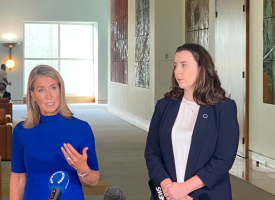Transcript - Dr Bartone, 6PR, Private Health Insurance
Transcript: AMA President, Dr Tony Bartone, 6PR, Breakfast with Steve Mills and Basil Zempilas, Monday 16 July 2018
Subject: Private Health Insurance
BASIL ZEMPILAS: This story around yesterday, Millsy, the gold, silver, and bronze, and then basic level, or tiers, if you like, for health insurance to try and simplify the process so that there's no more getting caught short. I thought I was covered for that, but no I'm not.
STEVE MILLS: Look, I don't know how this is going to solve this because at the moment they do have descriptors in regards to what do you want in your health cover. Well, my policy does. So, when you think you've got gold, you might be under the false assumption that I am covered when you're actually not. So, I don't know how gold, silver and bronze and basic are actually going to help us. Dr Tony Bartone is the President of the AMA and joins us right now. Good morning to you.
TONY BARTONE: Good morning.
BASIL ZEMPILAS: Are you happy with this set up?
TONY BARTONE: Well, what we need to remember is that this is an improvement on the bit of a mess that we've got at the moment. We've got nearly 70,000 different policies, lots of restrictions, lots of inclusions, lacking transparency, lacking clarity in what you're covered for, and what you're not. This is a step in the right direction. You're right, we do need some further information and that'll be around the clinical definitions and the rules which underpin a lot of the procedures in each of the categories. But there are some areas that we're not happy with. We've been very strong in calling and advocating for them, such as pregnancy, should be included in all the tiers. But it's only going to be available in the top cover, the gold cover. But it certainly is going to improve the information and the clarity, but we still just wait that last bit of the puzzle...
STEVE MILLS: Right.
TONY BARTONE: … clinical rules and definitions, which will then give us complete visibility and be able to then truly compare apples with apples when it comes to the cost of the different policies out there in the community.
BASIL ZEMPILAS: I don't know whether you'll ever be able to compare apples with apples because it's too complicated. I mean, this is due to get off and running in April of next year. But one area that I reckon is one that we can all agree on is junk policies. How many people would have a health policy that is completely rubbish? In other words, when push comes to shove, there's just no money there.
TONY BARTONE: Look, I can't give you an exact figure for that number, but certainly, it is a significant number. It was borne out essentially as a result of trying to avoid paying that Medicare levy surcharge for private health. And so, essentially, it's a tax deduction and, really, at the end of the day, it has really not offered any value to consumers. But there are other policies, including where you think you're covered for something and you come up to the 11th hour only to realise that it's an exclusion or a carve out, and that you've got either a very significant waiting period, or that you better go into the public system to have that procedure done because you're not covered for it. So, yeah, there are many examples of where the policy doesn't offer you the value that you thought you were being covered for.
BASIL ZEMPILAS: Yeah, quite right. Tony, we discussed this yesterday, but the gap, it's still an issue. I mean, Millsy and I, we talk about it quite often here on this program, but the gap is an issue that seems to sneak up on people and people go, hang on, I thought I had cover. They pay their bills, they get it all done, and then they're still left with a significant amount of money that they need to cover. As we know, as ‘the gap’. How do we get rid of that gap?
TONY BARTONE: This is a complex discussion, but let me try and break it down very clearly. The levels of cover that are paid for procedures by the health funds are based on schedules largely, and these Medicare schedules have not been either indexed, they've been frozen for five years, or have not been indexed appropriately for many, many years previously. And so, what we've got essentially is a table of rebates that bear no resemblance to the cost of providing good quality health care in our country. The other thing that I need to point out at this point is that if we look at the data, if we look at the APRA data on these rebates and on these episodes of care, 96 per cent, or just over, are performed at what we call a no gap. That is zero dollars on top of the rebate that's paid by the health insurers, or at a known gap of $500. So, the vast bulk of the procedures are being done within a very, very constrained and reserved environment.
BASIL ZEMPILAS: Sure.
TONY BARTONE: Trying to take into account the needs of our patients.
BASIL ZEMPILAS: Tony, thanks for having a chat to us this morning.
TONY BARTONE: My pleasure. Have a good day.
16 July 2018
CONTACT: John Flannery 02 6270 5477 / 0419 494 761
Maria Hawthorne 02 6270 5478 / 0427 209 753



